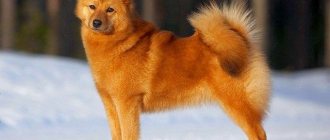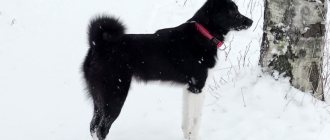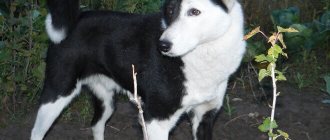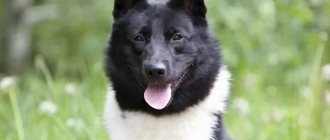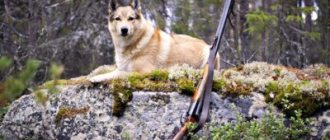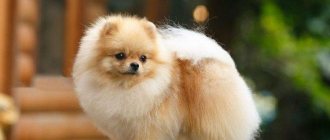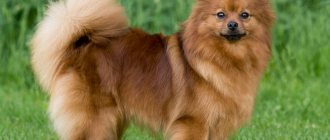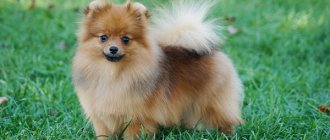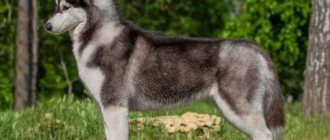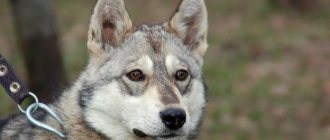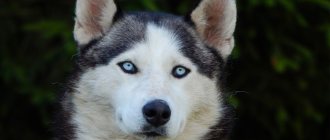| Origin: | Russia |
| Purpose: | multifunctional |
| Options: | Height – 44-52 cm for males, 40-45 cm for females. Deviation in height is allowed no more than 2 cm. Weight 10-15 kg |
| Color: | black, piebald, spotted, white, brown, red |
| Lifespan: | 14 years |
Beautiful appearance, balanced psyche, ease of maintenance and good working qualities are the reasons for the increased interest in such a breed as the Nenets Laika. The dog is equally good for keeping in the northern regions, where it comes from, and in the city. This is one of the most ancient and at the same time little studied breeds. All her advantages were formed by the harsh nature - unpretentiousness, endurance, good health. It is not easy to get such a dog.
Brief history of origin
The history of the origin of the reindeer Spitz, as the Nenets Laika is also called, begins in Scandinavia.
It was there that the ancestors of the breed, turf dogs, lived more than 5 thousand years ago. Over the long centuries of its existence, the breed has acquired many names: Samoyed dog, Nenets shepherd dog and others. From the Scandinavians, the northern dog came to the Finns and Nenets. Before the development of large-scale reindeer herding among the Nenets, the reindeer herding Spitz performed hunting functions. Only in the 19th century did huskies become faithful assistants to reindeer herders and nomads in driving livestock. Developed hunting instincts allowed dogs to prove themselves as excellent shepherds of a reindeer herd.
At the beginning of the 20th century, the breed appeared on the territory of Chukotka and Kamchatka. And since that time, the Nenets Laika has become a popular participant in dog shows.
The breed “Nenets Northern Reindeer Laika” and “Reindeer Spitz” received official recognition only in Russia. It is not included in the International Canine Classification.
Functional qualities
Reindeer huskies have an excellent sense of smell, allowing them to warn the shepherd in advance about approaching danger.
The dog has a lively, active character. Dogs are not malicious, but can be distrustful of strangers.
An important difference that is inherent in the breed is consistency and psychological stability.
Animals have a pronounced herding instinct; their hunting skills are less developed, but not lost.
Dogs have relatively small teeth and a habit of light grip. This feature is unique to herding dogs: Laikas are used for herding large deer and calves.
In all cases, dogs, driving up individuals that lag behind the herd with their bites, do not damage the legs of the deer.
When an animal is faced with a choice: start chasing potential prey or stay close to its owner, it chooses the second option.
The psychological state of these animals is characterized by balance, courage, and resourcefulness. Cowardice and increased aggressiveness are considered disqualifying signs of an animal.
Character and behavior
The Reindeer Spitz is an easygoing and sociable dog that easily finds a common language with humans and other pets. She becomes very attached to people, so it is difficult for her to endure long separation from her owner.
Important! It is almost impossible to give the dog into other hands. She will refuse to serve in someone else's house and, if the opportunity arises, she will run away in search of her old master.
The character of the Nenets Laika can be characterized by the following traits:
- friendly;
- active;
- seasoned;
- obedient;
- people-oriented.
Reindeer Spitz dogs have weakly expressed animal instincts. Therefore, they willingly adhere to discipline, love to learn and serve.
The Nenets Laika is wary of strangers, but does not show aggression. It is a balanced psyche that is considered the main distinguishing feature of this breed.
Expert opinion Leonid Rodin Experienced dog breeder Ask a question The widespread opinion about all huskies as sled dogs is completely wrong in relation to this representative of the aboriginal breed. Moreover, if local children unknowingly try to harness a dog to a sled, they will be punished by their parents. The Nenets use only reindeer for riding, and the main task of the husky is considered to be to help people work with the herd.
It is interesting that shepherds do not need any training of Nenets reindeer herders - the puppy receives all the skills from its mother. And people begin to take a closer look at the dog at six months of age to determine the work it is capable of. Moreover, there is a whole hierarchy of four-legged specialties. The most honorable one is called “you-malambada”. It is carried out by reindeer herders, who gather reindeer into a herd. Next come the animals, driving the herds to the house (ty-tavana), looking for the stragglers (malta-myta) and mercha-myta - holding the reindeer near the camp.
Of course, Nenets Laikas do not need all these natural skills when living in apartments. But as soon as the dog sees grazing deer or, for example, cows, the instincts of the ancestors instantly take over - the reindeer herders begin to excitedly work with the herd.
Breed and children
Dogs of this breed are true companions. They are ideal for single people and families with children.
Important! Reindeer Spitz are hardy and patient, so the dog will not perceive excessive activity from children as an irritant.
The Nenets Laika perceives childcare as a job where she needs to be attentive and take care of the living beings entrusted to her.
Application
The Nenets reindeer husky is the only herding dog. It is mainly distributed in areas of active tundra reindeer herding.
In the North, the Nenets Spitz is used to work with the herd. One dog replaces 2 shepherds. Laikas crowd the herd, urge up the lagging animals, and direct them in the right direction. They work very quickly. They easily overcome snowy expanses, swampy areas overgrown with dense bushes.
Nenets Laikas are also used for hunting wild deer. They catch up with the wounded animals and drive them towards the hunters.
They are also used for hunting geese and fur-bearing animals: squirrel, mink. However, the dog is not specifically taught to hunt. Local residents do not welcome it when a dog exhibits a strong hunting instinct.
Nenets respect their pets. They transport them on sledges, keep them in a tent, and feed them well. It is believed that a reindeer herder without a dog is not a reindeer herder.
The Nenets Laika has a lively mind and an easy-going character. She learns easily and quickly various types of service. She has versatile abilities, so the husky is used for rescue work, service in the police, customs and other areas.
This is a great companion. The reindeer will happily go with its owner for a long walk or hike. In the European part of Russia it is also used for hunting. In some cases, she copes with this task better than hounds.
Interesting Facts
There are many interesting facts related to the Nenets Laika:
- The Reindeer Spitz is born large and noisy. A loud squeak will prevent the puppy from losing its mother in northern conditions.
- From the first seconds after birth, the puppy is able to suck milk, unlike representatives of other breeds.
- In the litter, preference is given to male dogs, destroying females. Strict selection allows us to avoid losses among herding and riding animals during the estrous cycle.
- The Nenets valued the black and piebald color in dogs. Thanks to him, the four-legged friend could be easily seen both in the snow and in the foliage.
Photo gallery
In the photo selection that we presented, you can take another look at these hardy and strong-willed dogs of the North.
Appearance of the breed
Reindeer Spitz are typical northern animals. They are distinguished by strength, high speed and unique external characteristics. The exterior of the dogs is attractive, and at the same time they are very hardy with quite massive dimensions. The external characteristics of the Nenets Laika are represented by the following features:
| Appearance | Characteristics |
| Dimensions | The height of adults at the withers reaches 41-53 centimeters, and the weight is about 20-25 kilograms. |
| Head | Wedge-shaped, and the transition from the muzzle to the forehead is clearly expressed. There is also a different length of fur, which makes the stop even more accentuated. |
| Muzzle | Pointed. Equal in size to the length of the skull. |
| Jaw | Large, strong. The teeth are snow-white and fit tightly together. The formula is complete. A scissor bite, but after the animal reaches 4 years of age, a straight bite is also allowed. |
| Ears | Small in size, standing. The shape is similar to an equilateral triangle. The position is high, the landing is wide. The ears are movable, the tips point upward. |
| Eyes | Almond-shaped, small in size. Lively and expressive look. Color yellow or brown. |
| Body | Strong and muscular. The withers are well developed, especially in male representatives of the breed. The back and croup are wide and straight. The chest is moderately wide. |
| Paws | The limbs are strong with well-developed muscles. Parallel, the rear ones are set slightly wider than the front ones. The paws are oval, the toes are slightly bent. Profitable fingers must be docked. |
| Tail | Long, reaching to the hock, but may be slightly shorter. It can be thrown over the back in the form of a ring or semi-ring, and also lowered down straight or in a semicircle. |
| Wool | The coat is the main advantage of the species. The guard hair is long, and the abundant and dense undercoat is soft. This volume of wool allows the animal to withstand very low and high air temperatures. Color can be black, white, red, piebald, brown, spotted. |
This exterior emphasizes the beauty and impeccability of the Nenets Laika. External beauty is complemented by ideal working qualities.
Standard requirements
The German Spitz breed standard differs in different countries. Thus, FCI and RKF classify all varieties into one group. And in the USA and England, the Keeshond and the German miniature Spitz are considered separate species.
5 types – 5 standards
The FCI German Spitz breed standard identifies the following species:
- German Wolfspitz Keeshond. The color is wolf (zonal gray), height – 43-55 cm.
- Large German Spitz or Grossspitz. Reaches 42-50 cm. Color – brown, black, white.
- Medium German Spitz or Mittelspitz. Color – red, black, zoned, brown, white. Other suits provided for by the standard are allowed. Height – 30-38 cm, weighs up to 11 kg.
- Small German Spitz or Kleinspitz. The suit options are the same as for the Middle Spitz. Size – 23-29 cm.
- German Miniature Spitz, also Pomeranian or Pomeranian. The color is the same as that of the medium and small German Spitz. Height 18-22 cm.
The standard allows other colors: cream, sable - orange or cream, black and tan and spotted colors. The last suit implies a basic white background with spots. It can be black and white, brown, gray or orange and white.
Although the German Mini Spitz is not recognized as a standard breed, its popularity is off the charts. It comes in two types: bear-type and doll-type. The dogs of these varieties have cute faces that resemble seals or bear cubs. However, they are living toys. Pets carry the dwarfism gene. Such animals are a degeneration of the breed.
Wolfspitz photo
Photo of Grossspitz.
Photo of the Mittelspitz
Kleinspitz photo
Photo of the orange
General requirements
Apart from differences in size and color, the German Spitz breed standard is common to all dogs. The table below reflects it.
| Options | Characteristic |
| Frame | The back is not long, straight with a wide loin. The belly is tucked in, the chest is wide and voluminous. |
| Leather | Fits tightly to the body, without folds. |
| Head | Medium, wedge-shaped, but not sharp. The ratio of the muzzle to the skull in Keeshonds, large and medium-sized dogs is 2:3, in small and Pomeranians it is 2:4. |
| Neck | Relatively long, wide at the shoulders, with a slight bend. Decorated with a mane. |
| Ears | Small, triangular, pointed. |
| Eyes | Almond-shaped, small, stand slantingly. The color is dark, the eyelids are black, in brown dogs they match the color. |
| Nose | Small, round, matching color. During the seasonal change of coat, in cream-colored dogs and in old dogs, lightening the middle of the lobe is acceptable. |
| Lips | Without jowls, tightly covering the teeth, pigmented to match the color. |
| Bite | Scissor-shaped, perhaps pincer-shaped. |
| Forelegs | With well-developed muscles, elbows pressed to the chest. |
| Hind limbs | Muscular, straight. Abundantly cleaned - so-called. skirt or pants. |
| Paws | In the shape of a cat's paw. The pads and claws are black. |
| Tail | It stands high, rises from the base to the top, is twisted into a ring and lies on the back. |
| Wool | Double, without curls. The spine is straight, the undercoat is abundant and fluffy. The neck, chest, belly, back, tail, back of the limbs are covered with long hair. An adult dog's coat should be silky to the touch, not cottony or fluffy. |
Education and training
Nenets reindeer racers are very smart and quick-witted, they quickly understand what is wanted from them and grasp commands, as they say, on the fly. Very owner oriented. Their upbringing requires moderate severity. In training, for the most part, the “carrot” is used, but sometimes you have to resort to the “stick”. The key to success is the dog’s interest in learning.
The psyche, physiology and exterior of the Nenets Laika make it capable of a wide variety of services in various conditions of detention and climate, with the exception of those where a large, angry dog is needed.
Traditional education of reindeer races
Nenets Laikas begin to be attracted to work only at the age of about a year. The dog is allowed to grow and form. “Unripe” mentally and physiologically, she will quickly weaken and will not work well. Young huskies are trained to herd with older, experienced dogs. They are not allowed to be distracted; they are praised for a job well done. Serious offenses are followed by serious punishments, after which the dog is tied up so that it does not get offended and run away. After some time, Laika will be ready to work without errors.
general characteristics
The original purpose of the breed was bird hunting. They took it with them to catch partridges, geese and other similar game. She looked for birds by smell, stood nearby (but so as not to scare away the prey) and began barking until the hunter fired a shot. Occasionally used as riding vehicles. These dogs are not very strong, but they can help out in a difficult situation and help drag a load or drive a sleigh.
Today they are kept more as a companion dog or a family pet. But they are often used for hunting. They have retained their instincts and loyalty to their owner, so they behave correctly when hunting, do not make much noise, and can lead on the trail, help drive or catch prey. They are completely indifferent to game. Some individuals may not even eat a bird caught by the owner.
According to the ICF standard No. 276 Norrbottenspets, males have a height of 44 cm at the withers, and females - 41 cm, deviations from the norm are possible up to 2 cm. The weight of the animal is 12-15 kg.
Care and maintenance of an adult dog
To maintain health and an active life, your pet needs proper nutrition, hygiene, moderate exercise and discipline.
The right diet
In the northern regions, Nenets Laikas are fed cereals, deer blood soup, fish and meat. In the summer, dogs can get their own food by catching mice.
This is interesting! At low temperatures, the reindeer Spitz at home is fed only at night - once a day. Otherwise, the morning “breakfast” will reduce activity in the pasture.
In urban conditions, the animal does not have to bear responsibility for the herd. Therefore, dosing food is an important condition.
Protein products should predominate in your pet’s food (70–80%), since carbohydrates can make him fat:
- sea fish;
- quail or chicken eggs;
- cottage cheese 2–3% fat, sour cream, kefir;
and
- porridge;
- fresh fruits, vegetables and herbs.
In order not to harm the health of the animal, you need to exclude the following products from the diet:
- food from the human table;
- citrus fruit;
- legumes;
- yeast and butter baked goods;
- sweets;
- smoked and fatty foods.
Professional food can be used to feed the Nenets Laika, but natural food is better suited for native breeds.
Walking and physical activity
Reindeer Spitz are freedom-loving animals. They find it difficult to endure confined spaces, especially if we are talking about a small apartment.
Important! The optimal conditions for keeping a pet are a private house or cottage with access to the street.
A dog of this breed requires active activity: regular walks and physical activity. You can splash out the energy of the Nenets Laika:
- in stadiums equipped with obstacles;
- in the forest, jumping over logs;
- in the fields, running after a stick or ball.
You need to walk with your pet at least 2 times a day for 60 minutes.
Training and education
Unlike other breeds, Nenets huskies are highly trainable. Before the puppy is one year old, it is necessary to teach basic commands:
- "To me!";
- "Ugh!";
- "Near!";
- "Fas!";
- “Aport!”;
- "Give!";
- "Place!".
After the dog is 12 months old, it can be trained for official duties - herding livestock, searching for people and objects, guarding the house.
Initially, it is advisable to train the Reindeer Spitz in the company of a more experienced dog, rewarding good work and punishing faults. Gradually, the Nenets Laika will stop making mistakes, relying on the experience of the companion and the assessment of the owner.
Care and hygiene
The animal's fast metabolism and thick coat provide the Nenets Laika with abundant shedding. In hot climates, dogs can change their “clothes” several times a year. In a city apartment, your pet will have to be combed at least 2 times a day during the molting period.
Important! In addition to standard brushes for grooming hair, a Furminator is purchased for the reindeer Spitz.
Dogs of this breed love water. But they should not be washed more often than once every 3-4 months.
Basic hygiene procedures for huskies are no different from caring for other dogs:
- The animal's eyes are checked and its ears are cleaned regularly once a week.
- Special sticks are purchased from veterinary pharmacies for cleaning teeth.
- The strong claws of the Nenets Laika grow quickly and do not have time to wear down, which is why they cause discomfort. They are trimmed periodically.
Nutrition
Representatives of this breed need to be fed:
- meat;
- fish fillet;
- vegetables;
- porridge;
- fruits.
At home, if there is an excess of carbohydrates, four-legged pets are prone to obesity. For this reason, it is very important to control the diet of Nenets Laikas and pay more attention to protein foods.
Premium dry dog food
Rating
Holistic dog food
Rating
Small breed dog food
Rating
Health
The Nenets Laika is a very healthy breed, primarily because the selection was carried out by nature itself. They do not have a long list of genetic defects. This is partly due to the fact that humans also carried out a harsh selection: unhealthy puppies were killed, and adult dogs were not treated. If she managed on her own, she was left with the family. Thus, only the best reindeer races remained for further reproduction.
The average lifespan of reindeer huskies is 14 years. Some individuals live up to 16 years, remaining in good physical shape.
Breeding
In their natural habitat, northern animals mate on their own. It is not recommended to breed herding dogs and hunters. In such situations, puppies demonstrate very strong hunting instincts, which leads to feral behavior. Another disadvantage of such selection is the presence of short fur in the offspring: it does not allow the dog to feel comfortable in difficult weather conditions. Also, short-haired four-legged pets are not protected from the negative effects of insects.
How to choose the right puppy
Purebred puppies are not a cheap pleasure. The average cost of a Nenets reindeer husky in Moscow is 100,000 rubles. But the expense is nothing compared to the joy this amazing dog will bring to your home.
In our small homeland, when purchasing a pet of this breed, people are mainly interested in its working qualities, and not in its appearance. But outside the tundra, when buying a puppy, you should carefully evaluate all the characteristics of the exterior. This will help prevent deception on the part of an unscrupulous breeder. In puppies it is already possible to evaluate the main characteristics of the breed:
- The head should be wedge-shaped, with a pronounced occipital protuberance and neat lines of the skull. The dog's muzzle may be slightly shorter than the skull.
- The build of the puppies should be strong and resemble a “square” shape.
- From birth, reindeer Spitz dogs have large paws, strong bones and massive toe pads, between which there must be fluffy and dense fur.
- The coat of puppies is an important indicator of the quality of the breed. It should be thick and have a double structure.
When choosing a companion, you need to pay attention to the activity of the pet. The puppy should be playful. A lethargic dog may indicate poor health.
Nenets Laika in art
Head of a Nenets Laika (reindeer Spitz).
The Nenets Laika is depicted in the paintings of the Nenets artist, member of the Union of Artists of Russia, Leonid Lara
in the series of works “Shamans and gods of the peoples of the North”, as well as the Nganasan artist
Motyumyaku Turdagin
.
The famous photographer Sergei Anisimov
, who has made many expeditions to the Arctic, captured the Nenets Laika in its native environment.
Nenets Laikas, their shepherding service and the Nenets way of life are shown in several documentaries:
"An amazing journey to the tundra." Author of the film: Arthur Ryabitsev, Hanaway studio.
“Yaptik-Khese” is the spirit of the Yaptik clan. His home is the road. As long as Yaptik-Khese roams, there will always be deer, dogs, and Nenets on the earth.
The AirSportRussia studio together with Korean documentaries made the film “Tundra”, which also contains scenes with Nenets huskies. Three episodes of this film are available online.
Nenets Laikas are featured in the documentary film “Nyarma”, filmed in 2008.
“Veneko Naltoko” (Laika nicknamed Nalto) is a song dedicated to the Nenets Laika performed by Elena Laptander.
“Notes of a Naturalist” - in this book, Evgeny Spangenberg described his travels across the vast expanses of Russia in the company of a Nenets Laika.
In addition, the Nenets Laika is included in the sculptural compositions of monuments in the cities of Nadym (Yamalo-Nenets Autonomous Okrug) and Naryan-Mar (Nenets Autonomous Okrug).
Disqualifying faults
For representatives of this breed the following are unacceptable:
- Deviations in height even by 2 cm.
- The appearance of age spots on the nose.
- Tiger color.
- An undeveloped undercoat and short coat are also disqualifying characteristics.
- Poorly developed muscles and loose skin.
- Muzzle too wide or narrow.
- Disproportional head.
- Large ears that droop or stand poorly.
- Worn teeth or discoloration of incisors.
- Weak back or sagging lower back.
Hunting
No matter what difficulties await the Karelian owner during basic training, hunting training always goes quite easily and quickly. Modern hunting with the Karelo-Finnish Laika involves tracking prey (birds, fur-bearing animals), indicating the location with a stand, barking and detaining (if necessary). A working dog should not bite or kill prey, of course, unless it is a matter of self-defense.
Training in hunting skills begins at the age of 7–12 months, depending on the moral maturity of the dog. Before going out into the field and getting acquainted with “training game,” the student must overcome fears of noise, shots, loud screams, water and weather conditions. Also, the four-legged dog must clearly follow basic commands: “Near”, “Come to me”, “Ugh”, “Sit”, “Lie down”, “Place”. If necessary, the dog is taught the commands “Voice” and “Quiet”.
A grown-up Karelo-Finnish Laika is taught to stand up and restrain the excitement of the hunt. A bird is used as a “simulator”, which is released from its hiding place. After performing the bark ritual, the bird is caught and placed in a cage. According to many hunters, destroying game in the first training sessions can frighten the dog.
For a full-fledged, adult hunt, a young Karelian female is bred in a group. A prerequisite is the availability of documents on breed and passing working tests. Shooting practice is conducted to ensure the safety of the dogs. If a four-legged animal is disobedient while hunting, it may become a victim of a “stray bullet,” and this is a tragedy for both the owner and the shooter.
Exterior
A distinctive feature of Spitz-types is thick, luxurious fur, which can consist of two layers - a long and thin top layer and a thick, dense undercoat. An animal's fur usually requires special care; simply brushing it is not enough.
The appearance of Spitz-type dogs is familiar to everyone - they have strong bones, are rationally built and have a medium-long tail, curved towards the back.
This family of dogs is distinguished by elongated muzzles and pointed ears.
They, as a rule, have excellent health - there are no signs of long-term artificial selection, so they do not suffer from genetic diseases.
Spitz dogs have a stable nervous system and good reflexes; they are optimal in size and weight. Thanks to long-term natural selection, they are hardy and adapt to various, even extreme conditions.
Individuals with good health, stable psyche and no signs of aggression towards humans were selected for breeding. They were traditionally valued not for their appearance, but for their performance.
Keeshond
Diseases of the Swedish Vallhund
The Swedish Vallhund is a dog with northern roots, so it has fairly good health and adapts well even to harsh environmental conditions. Life expectancy with proper care is 12–14 years
When buying a puppy, you should pay attention to the health of its parents, since the breed most often has ailments that are of a hereditary nature:
- Hip dysplasia. Congenital pathology of the development of the pelvis leads to chronic dislocation, which causes pain and does not allow the animal to move normally. Having discovered that your pet is pressing its back paw and has stopped actively playing, you need to go to the hospital - the only solution to the problem is surgery.
- Retinopathy (damage to the retina). The main symptom is a noticeable deterioration in vision. If left untreated, the disease progresses and leads to blindness. The veterinarian can prescribe either medication to treat the problem or surgical intervention - everything will depend on the severity of the case.
West Siberian
This breed is the most numerous, in terms of the number of heads, and the most common among hunters. It is distinguished by its predatory appearance; it is more like a wolf in color and temperament than others. Not large in size - 52-60 cm at the withers, with a weight of 16-22 kg. Externally a strong animal, elongated format. It is considered a universal hunting dog.
In proportions and appearance it is not much different from the East Siberian. A special feature can be considered deep-set, sharply slanted eyes and a predatory gaze. Preferred colors: white, piebald, brown, gray, red.
The breed does not cause any difficulties in caring for. West Siberian huskies are unpretentious. They can go for a long time without water and food, work hard, and hunt. Such dogs need space; living in an apartment will negatively affect their well-being. In order for a pet to live on the street, it needs to be equipped with an enclosure or a booth with a soft chain
It is important to regularly go hunting with your animal or just for walks in the forest.
A puppy without a pedigree can be purchased for 3,000-5,000 rubles, a pet-class or breed-class dog for 15,000-20,000 rubles, a show class dog for 25,000 rubles.
Polar antiquity
The centuries-old chronology of this Laika variety contains many toponyms: Nenets reindeer Spitz dogs were called Samoyed shepherd dogs, Tavgian reindeer dogs, Arctic reindeer dogs.
The history of this Spitz-like branch is a real detective story. The canine majority still claims the European origin of these polar Spitz. The basic theory is that the Yamal Peninsula is the transit domain of the species. The genetic “source” came to the Russian northern outskirts from the Vikings, who imported the Spitz dogs (descendants of peat dogs) from Europe, then the dogs came to the Lapps-Sami, and only from these great nomads did the reindeer herders go to the Nenets. Details, as always, are shrouded in the darkness of myths and legends, but the official date of acquaintance of the canine community with the Yamal shepherd dogs took place at the very beginning of the nineteenth century: at that time the Nenets migrated massively from the distant shores of Pechora to the slightly more developed Kola Peninsula. The enormous value for historians lies in the fact that the Nenets herding Spitz has not changed at all since the ancient times of Neolithic hunters. Due to the isolation and inaccessibility of its habitat, the Spitz species has avoided crossing with other canids. In fact, this is the original type of the famous “peat dog of the Neolithic pile villages”, the patriarch of the entire “motley” and numerous family of European huskies.
Karelian Bear
An ancient Finnish breed, which, as the name suggests, is used for bear hunting. Very similar in appearance to the Russian-European Laika, has the same color, build and coat length. The dog is small in size - 52-57 cm at the withers, 1 7-27 kg in weight. The body is elongated, lightweight, elegant.
The breeding and restoration of the breed began in 1936, the standard was written in 1945. Like other huskies, these are classified as the fifth group and the second section.
Like most Laikas, Karelkas have a long wedge-shaped skull , an elongated dry body , straight paws a tail thrown into a ring . The color can be white or black with large spots.
These huskies can live in apartment conditions, but the best option, of course, would be a country house with a fenced area. The climate is needed to be cold or temperate, because heat, like its counterparts, is destructive. The wool is regularly combed and water hygiene procedures are carried out a couple of times a year.
60,000-80,000 rubles for a purebred representative . Without a pedigree, puppies cost about 15,000-20,000 rubles .
Nenets Laika in art
Head of a Nenets Laika (reindeer Spitz).
The Nenets Laika is depicted in the paintings of the Nenets artist, member of the Union of Artists of Russia, Leonid Lara
in the series of works “Shamans and gods of the peoples of the North”, as well as the Nganasan artist
Motyumyaku Turdagin
.
The famous photographer Sergei Anisimov
, who has made many expeditions to the Arctic, captured the Nenets Laika in its native environment.
Nenets Laikas, their shepherding service and the Nenets way of life are shown in several documentaries:
"An amazing journey to the tundra." Author of the film: Arthur Ryabitsev, Hanaway studio.
“Yaptik-Khese” is the spirit of the Yaptik clan. His home is the road. As long as Yaptik-Khese roams, there will always be deer, dogs, and Nenets on the earth.
The AirSportRussia studio together with Korean documentaries made the film “Tundra”, which also contains scenes with Nenets huskies. Three episodes of this film are available online.
Nenets Laikas are featured in the documentary film “Nyarma”, filmed in 2008.
“Veneko Naltoko” (Laika nicknamed Nalto) is a song dedicated to the Nenets Laika performed by Elena Laptander.
“Notes of a Naturalist” - in this book, Evgeny Spangenberg described his travels across the vast expanses of Russia in the company of a Nenets Laika.
In addition, the Nenets Laika is included in the sculptural compositions of monuments in the cities of Nadym (Yamalo-Nenets Autonomous Okrug) and Naryan-Mar (Nenets Autonomous Okrug).
Appearance
The first thought that arises when taking a quick look at a Swedish Husky is – is it a dog or a wolf? And indeed, in its color and physique, this breed is strikingly similar to its free relatives (it is especially easy to confuse them in the photo). Shows a slightly changed exterior and a different eye color. Although in terms of size, the Swedish husky is more likely to be a large dog. The size standards are as follows:
- The height of males is 57-65 cm;
- The height of females is 52-60 cm;
- Male weight: 22-29 kg;
- The weight of females is 21-27 kg.
Now a little about the constitution. The emthund's body itself is slightly elongated, although close to square. The length is slightly greater than the height. The head is pointed, with pointed and erect ears. The back is slightly sloping from the withers to the croup. The tail is usually curled into a rakish pretzel over the back and very rarely droops down.
In terms of colors, the most common and appreciated at exhibitions is zone gray. Along with it, only darker and lighter options are acceptable. However, the presence of gray is mandatory, with white paws and tail, as well as white lines on the neck.
